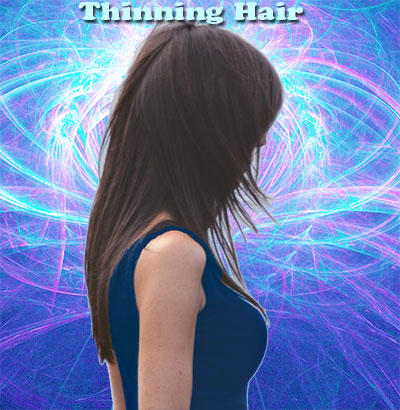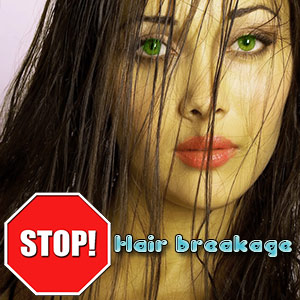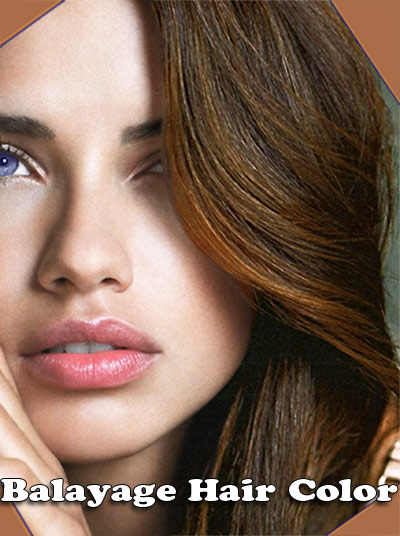Thinning Hair Remedies

A record 30 million American women have thin hair. Hair thinning on the head can be demoralizing. It influences appearance. Instantly, the search for volumizing sprays, detoxifying tonics and shampoos begins. If none works, the last resort might be to shave off hair and sport a hair-do that befits thinning hair. For some the choice can't be that simple.
Wigs and fake hair was for the ancient Egypt royals. A radical hair treatment for hair loss discovered by Hippocrates, the Greek Physician is redundant. Covering hair with a laurel wreath like Julius Caesar is impossible. The latest options are products with stem cells that can grow hair. Instead of being suckered into any of these, check out the causes of thinning hair.
Thinning hair
By conventional means it is impossible to determine the diameter or width of your hair. Nor would any commoner be keen in using the Young's double slit experiment or the laser pointer. Natural hair rules would suffice to determine and classify hair as thick, medium and thin. The hair strands need not be individually counted. It is actually how well the hair strands cover your scalp counts.
Here is a D-I-Y method suggested by hair professionals.
Step 1: Pull back hair into a ponytail and measure the circumference of the ponytail.
Step 2: Measure it. Use a sewing thread which is soft and pliable.
Classify: Thin hair measures less than 2 inches in circumference.
Thick hair measures 4 inches or more in circumference.
The single strand test
Step 1: Take a single hair in between your fingers.
Classify: Feel you are holding anything, then its fine hair.
Feel the hair, then its medium
Feel a strong, thick strand, and then it's coarse.
For the plain lazy types, the simpler strand test to measure hair density is appropriate.
Step 1: Stand in front of the mirror and grab a handful of hair at the side of your head.
Classify: Look for the space around that ‘clump'. If the scalp is easily visible, the hair is thin and if no scalp is visible your hair is thick and half-way is regarded medium.
At the end of the exercise you may notice any of these. Your hair might thin all over, or your center part could get wider and wider or even a bald spot at the crown of your head can develop.
Thinning hair causes
Hair thinning is far more common than we realize. Men experience hair thinning as much as women. But there is a difference. The very first difference is the hair. Men have a greater growth rate than women. Attribute it to testosterone. A man's hair grows faster and is thicker as well. This explains why men sans the long mane opt for haircuts more often. Hair thinning in men is more related to male pattern baldness. And, 80% of male pattern baldness is related to hereditary. Only 30% of hair thinning in women which is related to female pattern baldness is due to heredity. What are the other reasons for hair thinning ?
Female pattern hair loss
Female pattern hair loss also called androgenetic alopecia affects 30 million American women. It can begin in the early 20s. It is most common after menopause. Women reaching menopause may notice the part widening and hair thinning. Genes play a role. FPHL can be inherited from either parent.
Due to treatments
Chemotherapy: While undergoing chemotherapy, the chances of hair loss not just in the scalp but all over the body are a very real common side effect. Intake of chemotherapy drugs bring about a rapid change in the body. Medications attack rapidly growing cancer cells. In the process other rapidly growing cells in the body including the cells in hair roots are also attacked resulting in hair thinning and in some cases complete baldness. However, in most cases this is temporary and after treatment visible changes in hair density can be noticed.
Radiation: During radiation only the specific treatment area is affected. If radiation is given to the head there will be loss of hair on the head. Radiation to other parts of the body will not cause loss of hair on the head. However, there is a rare possibility of an area where the hair is permanently thinner.
Due to changes in body
Polycystic ovarian syndrome (PCOS): A side effect for women with PCOS is hair thinning. PCOS can cause hyperandrogenism when the body produces too many androgens (male hormones). Androgens are found naturally in all women. There is an excess level during PCOS. If the hair follicles are sensitive to androgens it affects growth of hair on the scalp, shrinks hair follicles making it difficult for healthy hair to survive and increases growth of hair in few areas (Hirsutism). Hair thinning from PCOS can be treated. If left untreated the condition can aggravate female pattern hair loss.
Thyroid levels
Hair loss, hair thinning and thyroid levels are inextricably linked. Thyroids control the efficiency and speed at which the cells work, including the cells in hair. Over-active thyroid (hyperthyroidism) or under-active thyroid (hypothyroidism), the link is inevitable. There are many signs related to hyperthyroidism and hypothyroidism, one being hair thinning.
Hypothyroidism indicates there isn't enough thyroid hormone (T3 and/or T4) in the body. The low levels impact body's ability to regenerate cells. This brings about changes in hair. There is excessive dryness and the hair becomes brittle with obvious signs of thinning.
Hyperthyroidism is a result of overproduction of thyroids, T3 and T4. Thinning hair and excessive shedding of hair is a common symptom of hyperthyroidism.
Thyroid disorders can be treated by medications or, in some cases, surgery. Treatment will depend on the particular disease of the thyroid.
Autoimmune disease
Immune system protects the body against infection and disease. Instead, if it attacks healthy tissue it indicates an autoimmune disease. Alopecia areata is an autoimmune disease. Here, the immune system treats hair as a foreign element and targets hair follicles by mistake. Damaged hair follicles can no longer hold the old hair shaft and it falls out or breaks off. The hair falls out in round patches. The exact cause is unknown. But, genes may play a role. Typically this can be termed hair loss but it does impact remaining hair strands to thin.
Discuss with your doctor to understand the underlying cause. Address and treat the underlying cause to enjoy a vibrant good health.
Hormonal imbalance
The two dominant female hormones, progesterone and estrogen are vital female hormones. The hormones can begin to decline and lose balance as early as the 30s. The imbalance brings along a set of changes, hair shedding and hair thinning.
If progesterone levels are too low, it can trigger excessive hair shedding and ultimately hair loss. When the estrogen levels tend to drop, the hair follicles are influenced by the male hormone testosterone. It causes the hair follicles to grow shorter and thinner. Symptoms of male-pattern baldness and hair growth on the face, hair fall and hair thinning are evident.
There are ways to nurture hormonal health. This includes eating well, practicing some form of exercise, getting enough healthy fats including omega 3 fatty acids, getting adequate, good quality sleep and discussing with the doctor for a prescription medication that supports hormonal balance.
Taking the pill
Intake of wrong oral birth control can weaken hair. For example, an androgen sensitive person taking a pill containing androgens can experience hair loss and hair thinning. Women opting for oral birth control can check androgen sensitivity by taking a cheek-swab genetic test.
Pregnancy
The hair may be thicker during pregnancy thanks to increased estrogen levels. An increase in estrogen level stimulates hair growth. But a few weeks or months after delivery, it is normal to lose hair. This may cause the hair to appear thinner than usual. The body is adjusting to changes in hormone level. Within six months after delivery, the regular hair growing cycle sets in.
Physical or Emotional Stress
High fever or severe infection, major surgery, sudden blood loss, extreme emotional stress, crash diets with minimal protein, any one or a combination of these can impact hair thickness. One-half to three-quarters of scalp hair is likely to be shed.
How does this happen? There are different stages of hair growth. Anagen phase is the stage of active growth which can last up to three years. About 80% to 90% of hair follicles are involved in this active growing phase. Next is a brief transitional phase that lasts for about three weeks. Known as the Catagen phase, a woman loses nearly about 5% of hair follicle during this phase. Then is the dormant period known as Telogen phase, when 10% to 15% of hair rests and this phase lasts up to four months. Following the Telogen phase, the growth phase begins again. The cycle is repeated.
After one to three months of stress - a major operation, accident, illness or childbirth, Telogen Effluvium occurs. As a result the hair's normal growth cycle is disrupted. Hair follicles prematurely stop growing and enter into the Telogen (resting) phase. Usually, only select hair is affected by Telogen Effluvium. These stay in the resting phase for about three months. Soon after, there is hair shedding and hair thinning. If the underlying cause is resolved, Telogen Effluvium ceases.
How do you cope? Reduce stress and learn ways to handle and deal with stress. Yoga and breathing relaxation methods are effective in reducing stress. Consider engaging in an activity that you enjoy most. Choose an exercise and be regular as it reduces stress hormones and stimulates production of endorphins, the brain's feel-good neurotransmitters.
Malnourishment
Nutrition does impact hair growth and hair loss. Nutrients are required for the growth process. For example, Vitamin E is most important for the growth of healthy hair and its maintenance. Vitamin E is the collective name for a group of eight fat-soluble compounds with distinctive antioxidant activities. The antioxidants protect cells from the damaging effects of free radicals which appear due to pollution and smoke and cause harmful effects to the body like thinning hair, baldness and premature graying of hair. Vitamin E has many other functions too. It is vital to the functioning of immune system. Eat a well-balanced diet.
Iron Deficiency
Deficiency in iron can result in thinning hair. Iron deficiency can cause anemia which means there is too little hemoglobin. Iron is an important component of hemoglobin. It is the protein in red blood cells that carries oxygen from the lungs and transports it throughout the body. When hair follicles don't get enough oxygen, it goes into a resting stage and hair falls out and doesn't grow back until anemia is improved. If signs and symptoms of iron deficiency persist; such as extreme fatigue and exhaustion, frequent infections, pale skin, swollen tongue, restless leg syndrome, hair loss etc. - it suggests low iron levels in the body. Eat well to restore healthy hair.
Medications
Intake of certain medicines to treat conditions can lead to hair thinning. The result is that more scalp can be seen than hair.
- Cancer medications
- Anti-depressants like Fluoxetine, imipramine, amitriptyline and doxepin
- Bipolar disorder medicines (lithium)
- Medicines for heart related ailments
- Medicines to treat Arthritis
- Acne tablets
- Common pain-killers (Ibuprofen)
- Psoriasis drugs
- Blood pressure pills like atenolol, lisinopril, losartan and valsartan
- Cholesterol lowering drugs like lovastatin or simvastatin
If taking these medicines is contributing to hair thinning, it is best to discuss with doctor. Alternative medicines may be prescribed for effective treatment.
Tinea Capitis or Ringworm of the scalp
Ringworm of the scalp or Tinea Capitis is a fungal infection. The fungi thrive in damp and warm conditions. Other contributory factors include poor scalp hygiene, wet skin due to excessive sweating or minor injuries to the scalp or skin. From the scalp, the infection can spread to eyebrows and eyelashes.
Look out for a range of symptoms like scaly skin, inflammation of the skin, appearance of sores filled with pus, dull and brittle hair. The infection is contagious and women are more prone than men. To diagnose, speak to a medical professional. Oral antifungal medications and an antifungal shampoo may be prescribed to relieve symptoms and treat Tinea Capitis effectively.
Mistakes that you might be making your hair appear thinner
Just like ways to make hair thicker, there are hair mistakes that make hair look thinner.
Using a hot styling tool
A good curling hair iron can add volume to straight hair or a superior flat iron can make curly hair super straight and sleek. Or even the blow-dryer, while using any of these the hair is exposed to extreme heat. Cuticles and proteins are subjected to extensive damage. As a result, the hair is prone to easy breakage.
Here is what professional hair experts recommend while opting to use a hot styling tool.
- Use a heat spray before using a hot styling tool.
- Restrict usage to two or three times a week.
- Blow-dry hair only up to 95%
- Remaining 5% let the hair dry on its own.
The absorbent towel
Aggressive towel-drying by rubbing hair in a harsh manner or combing soon after washing hair causes hair to break. Using an absorbent soft towel that soaks up excess water from the hair would do good. Hair experts recommend wrapping hair in a soft towel for few minutes to allow the excess water to be absorbed.
Wrong haircut and hair styles
Certain haircuts and hair styles make hair appear thinner. Consider face shape, hair length, hair texture or consult a hair expert to find the right haircut and hair style. For example, back ponytails and tight top knows pull on the hair follicle and result in hair breakage. Ultimately the hair looks thinner. Instead embrace your hair for what it is and explore safe tricks to enhance what you already have!
Using wrong hair products
From brushes to shampoo and conditioner, choose the most appropriate hair products for your hair type. Consider taking a hair test to know hair type. It could be super straight, wavy hair, curly hair, fine strands to coarse and kinky hair, and the test results come along with recommendations and styling tips for your specific styling needs.
Steamy showers
Steamy showers do no good to the hair. The heat only dehydrates the hair making it dry and brittle. There can be additional hair shedding and eventually the hair thins. Stylists recommend warm water wash to allow shampoo and conditioner to do their job and rinse with cold water which helps in closing the cuticles and retaining the moisture from conditioner.
UV rays
Unprotected exposure to the direct rays of the sun damages hair follicle. This can lead to breakage, hair loss and overall thinning of hair. A hat can provide complete protection against the damaging effects of UV rays.
Skipping hair wash
There is no minimum or maximum times of hair wash in a week or a month. It is the hair type, styling choices and personal preference that ought to determine how often to wash hair. Washing hair daily can strip hair of natural oils (sebaceous glands) that add volume and shine. Skipping hair wash for a prolonged time is detrimental to hair health.
The scalp is home to residue, dirt and oil from the sebaceous glands. All these clog the hair follicles. Clogged hair follicles cause acne breakouts. This can lead to hair loss and eventually hair thinning. Hair experts opine the right balance would be shampoo hair two or three times a week. This keeps hair clean and does not damage or dry the hair shafts.
Share tips
You aren't the only one with hair thinning. Don't let thinning hair to stop you from looking your best. Share tips and tricks to improve quality of hair.
If nothing helps, don't hesitate to seek professional. Discuss to find the cause, a health condition, medications, stress, or other lifestyle issues and proceed with treatment.
Top of the Page: Thinning Hair Remedies
Tags:#thinning hair
 Hair Loss
Hair Loss Thinning Hair Remedies
Stop Hair Breakage
Damaged Hair Care
Scalp Psoriasis
Hair Loss Treatment and Hair Restoration
Female Hair Loss
Menopause and hair loss
Pattern Baldness in Women
Hair Weaving
Hair Frizz
Ingrown Hair
Hair Care in Winter
Hair Masque
Hair Detanglers
Hair Color
 Covering Grays
Covering Grays Balayage Hair Color
Blonde Hair Long
Red Hair Color
Brunette Hair Color
Hair Highlighting
Eclipting Hair Color
Different HairStyles
 Easy Hair Style
Easy Hair Style Virtual Hairstyle
Punk Hairstyle
Celebrity Hairstyle
Asian Hairstyle
Interactive Hair Style Gallery
Messy Side Braiding
Braid Hair Style
Updo Hair Style
Kid Hair Style
Bob Hairstyle
Hair Perm
Hairstyles for Long Hair
Curly Hair Style
Medium Length Hairstyles
Hair style Tips
 Hair Parting Tips
Hair Parting Tips Hairstyles to look Younger
Washing Hair
Faster Hair Growth
Hair Makeover
Curling Iron
Hair Accessory
Laser Hair Brush
Hair Gel
Hair Transplant
Hair Extension
Hair Mousse and Hairspray
Blow Drying
Hair Dryer
Cysteine Hair Treatment
Hair Straightening
Laser Hair Removal
Human Hair Wig
Dandruff Shampoo
Top of the Page: Thinning Hair Remedies
Popularity Index: 104,419

